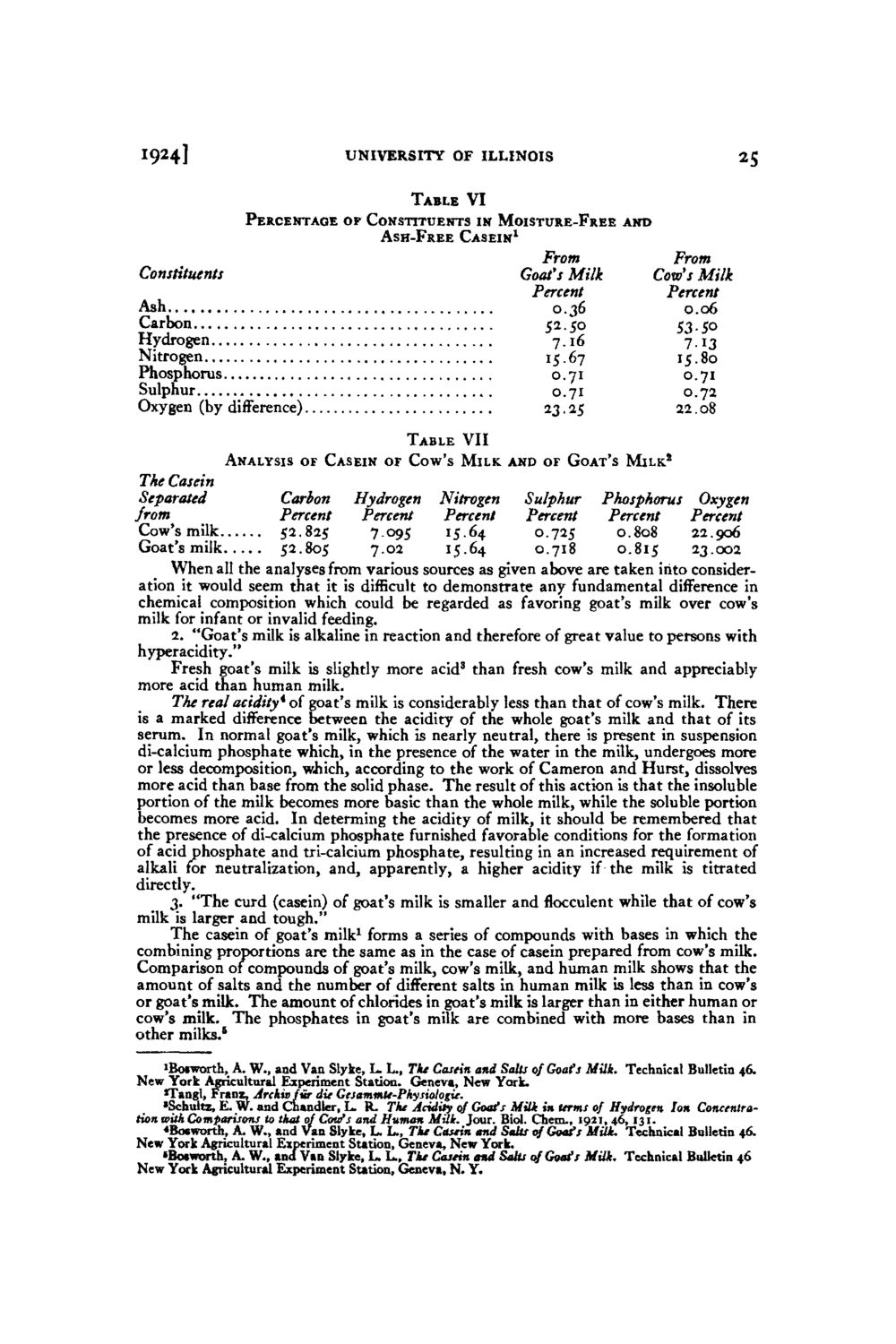| |
| |
Caption: Board of Trustees Minutes - 1926
This is a reduced-resolution page image for fast online browsing.

EXTRACTED TEXT FROM PAGE:
1924] UNIVERSITY OF ILLINOIS 25 Table VI Percentage op Constituents in Moisture-Free and Ash-Free Casein1 From From Constituents Goat's Milk Cow's Milk Percent Percent Ash 0.36 0.06 Carbon 52.50 $3-5° Hydrogen 7.16 7.13 Nitrogen 1567 15.80 Phosphorus 0.71 0.71 Sulphur 0.71 0.72 Oxygen (by difference) 23.25 22.08 Table VII Analysis of Casein of Cow's Milk and of Goat's Milk.8 The Casein Separated Carbon Hydrogen Nitrogen Sulphur Phosphorus Oxygen from Percent Percent Percent Percent Percent Percent Cow's milk 52825 7095 1564 0.725 0.808 22.906 Goat's milk 52805 7.02 15.64 0.718 0.815 23.002 W h e n all the analyses from various sources as given above are taken into consideration it would seem that it is difficult to demonstrate any fundamental difference in chemical composition which could be regarded as favoring goat's milk over cow's milk for infant or invalid feeding. 2. "Goat's milk is alkaline in reaction and therefore of great value to persons with hyperacidity." Fresh goat's milk is slightly more acid3 than fresh cow's milk and appreciably more acid than h u m a n milk. The real acidity* of goat's milk is considerably less than that of cow's milk. There is a marked difference between the acidity of the whole goat's milk and that of its serum. In normal goat's milk, which is nearly neutral, there is present in suspension di-calcium phosphate which, in the presence of the water in the milk, undergoes more or less decomposition, which, according to the work of Cameron and Hurst, dissolves more acid than base from the solid phase. T h e result of this action is that the insoluble portion of the milk becomes more basic than the whole milk, while the soluble portion becomes more acid. In determing the acidity of milk, it should be remembered that the presence of di-calcium phosphate furnished favorable conditions for the formation of acid phosphate and tri-calcium phosphate, resulting in an increased requirement of alkali for neutralization, and, apparently, a higher acidity if the milk is titrated directly. 3. "The curd (casein) of goat's milk is smaller andflocculentwhile that of cow's milk is larger and tough." iBwworth, A. of goat's milk1 forms a series of compounds Goats Milk. Technical Bulletin 46. The casein W., and Van Slyke, L. L., Tkt Casein and Sails of with bases in which the New York Agricultural Experiment Station. Geneva, case York. combining proportions are the same as in the New of casein prepared from cow's milk. Tangl, Franz, Arthis fir of goat's milk, cow's Comparison of compounds die GesammU-Pkysioloiit. milk, and h u m a n milk shows that the •Schultz,salts. and the number R- different salts in h MUi n milk is less thanIon Concentraamount of E. W and Chandler, L. of Tkt Acidity of Goafs u m a in urns of Hydrogen in cow's tion with Comparisons e amountCovfs and Human goat's Jour. Biol. Chem., 1921, either h u m a n or or goat's milk. T h to that of of chlorides in Milk. milk is larger than in 46,131. •Botworth, A. W., and Van Slyke, L. L., Tkt are and Salts Goat's Milk. Technical Bulletin cow's milk. T h e phosphates in goat's milkCdstincombinedofwith more bases than in 46. New York Agricultural Experiment Station, Geneva, New York. other milks.' •Boiworth, A. W., and Van Slyke, L. L., Tkt Casein and Salts of Goafs Milk. Technical Bulletin 46 New York Agricultural Experiment Station, Geneva, N. Y.
| |